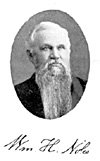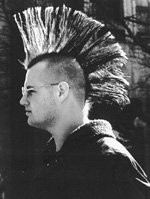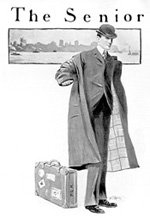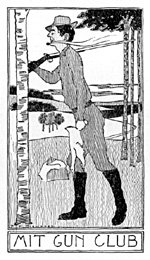The 20th century was good for MIT.
Dramatic change started with the move to Cambridge in 1916. Over the years, the student body and faculty grew larger and more diverse, the curriculum expanded, mining gave way to nuclear engineering, and naval architecture was overshadowed by aeronautics and astronautics. Cell phones, television and computers arrived. Slide rules disappeared.
With all that, the spirit and mission remain intact, not to mention the students' creativity and talent for good-natured hijinks.
Starting with Commencement, here's how the community and the class of 1900 compares with 2000:
One hundred years ago, MIT President James M. Crafts awarded degrees to 178 members of the Class of 1900, four of them women.
On Friday, President Charles M. Vest and Provost Robert A. Brown will present diplomas to 2,117 members of the Class of 2000, 705 of them women.
The top students in the 1900 graduating class -- among them one woman, Grace Langford in physics -- summarized their theses at Commencement. Hewlett-Packard president and CEO Carly Fiorina delivers this year's Commencement address.
In 1900, President Crafts told the graduates, "All our records show that you are more likely to remain more faithful to your training than graduates of any other kind of professional school, be it law, medicine or divinity."
In his message to the Class of 2000 in Technique, MIT's yearbook, President Vest said, "I have no doubt that, like the generations of graduates who have preceded you, you will indeed make the world a markedly better place. Some of you already have."
The 1900 exercises took place on June 4, a Tuesday, in Huntington Hall, one of five buildings on the expanding Back Bay campus. The weather was clear and cool. The 2000 exercises will be held on Killian Court in the midst of MIT's expanding 154-acre campus in Cambridge. This Friday's forecast: cloudy and cool.
The Class of 1900 included 142 engineering majors, among them 20 mining engineers and four sanitary engineers. The most popular courses were mechanical engineering with 33 graduates, civil engineering with 31, electrical engineering with 22 and architecture with 21. The class of 2000 includes 1,258 engineering majors, including 368 in electrical engineering and computer science.
The Class of 1900 included three biology majors and 16 chemistry majors. The Class of 2000 has 116 students who majored in biology and 30 in chemistry, among the 368 degrees awarded in the School of Science.
Professor Crafts, MIT's fourth president who was presiding at his final Commencement, awarded nine degrees in naval architecture. President Vest will award 30 bachelor's degrees in aeronautics and astronautics.
Athletes in the Class of 1900 had a new gymnasium for women, as well as track and baseball teams (each class fielded its own team), the Technology Wheelmen for cyclists, the Tennis Association and the Tech Yacht Club. The Class of 2000 has two boathouses, 41 varsity teams, 20 intramural programs with more than 1,000 teams participating, and the promise of a new athletic complex. The varsity football team compiled a 1-7-1 record in 1900, compared to 6-4 last season.
FROM BANJOS TO ROBOTS
For diversion, members of the Class of 1900 joined the Banjo Club, the Mandolin Club and the Chess Club. The Class of 2000 could join the Assassin's Guild, Roadkill Buffet and the Robotics Club.
Students who could carry a tune joined the Glee Club in 1900. Today they can choose among the Musical Theatre Guild, the MIT Gilbert and Sullivan Society, the Logarhythms, the Chorallaries, the Toons, the Muses, Techiya, Tech Jazz Singers and Cross Products.
Students and faculty wore starched shirts and ties to class in 1900. No comparison.
Members of the Class of 1900 hailed from 16 states, three foreign countries and Hawaii. Forty-six states, Puerto Rico, the Virgin Islands and 101 foreign countries are represented by the Class of 2000. In 1900, MIT had 1,171 students from 38 states and 13 foreign countries enrolled in 13 courses. In 2000, MIT has 9,885 undergraduate and graduate students from all 50 states, the District of Columbia and 102 foreign countries.
In 1900, 1.5 percent of MIT students came from foreign countries, including seven from Mexico and three each from England and Turkey. In 2000, 23 percent hail from overseas, including 259 from the People's Republic of China, 192 from Canada and 148 from India.
A hundred years ago, MIT had 58 female students. In 2000, the Institute has 1,768 female undergraduates (41 percent of the total) and 1,519 graduate students who are women (27 percent). There are 1,996 undergraduates from US minority groups and 673 minority graduate students.
In 1900, MIT had 164 instructors and lecturers, including 52 professors (all male), 51 of whom had beards and/or moustaches, as seen in the photos for that year's Technique. The number of men on the faculty in 2000 who sport facial hair was not available.
In 2000, there are 584 professors, 178 associate professors and 169 assistant professors on MIT's faculty. Of this group, 144 are women and 121 are members of American minority groups (including 15 women). There are also 423 senior lecturers, lecturers and professors emeriti, 102 instructors, six adjunct faculty, and 705 teaching assistants and graduate instructors.
CAMPUS FUNDS
The buzz on campus in 1900 centered on donations, financial aid and student housing. Augustus Lowell presented "the munificent gift of $50,000 to serve as the nucleus of an endowment fund for the benefits of the instructing staff," Technology Review reported in its June 1900 issue. The Institute had also earmarked $24,000 annually "for specific aid of worthy students."
The administration, while acknowledging the benefits of a campus in downtown Boston, was concerned about students living in rooming houses acquiring bad habits while members of the class chronicled romps through Scollay Square in the yearbook. It was suggested that they seek lodging with "nice families" in suburban homes. Even though Scollay Square has vanished from today's Boston, views of urban life have undoubtedly evolved in the last century.
The Class of 1900 included many students with colorful nicknames. (Nicknames for member of the Class of 2000 are being withheld to protect the living.) There was Albert Charles "Cy" Dart, whose 1900 classmates teased him for arriving late for sophomore year because he trained and rode a horse named Whitenose in the Illinois State Fair. (Whitenose was an also-ran.)
There were also Wilbert Wilberforce "Lengthy" Stone, Ralph "Shorty" Plumb, Paul "Oom" Brooks, George Anthony "Almighty" Hall, Frank David "Brindle" Chase, and Edwin Hibbert Dimock, known for wearing his gray sweater for weeks, perhaps even months, at a time. His nickname is unrecorded, since MIT students were gentlemen in those days.
The Class of 1900 adopted a quotation from Cicero as its motto: Vacare culpa magnum est solatium (it is a great consolation to be free from blame). How does one say IHTFP in Latin?
A version of this article appeared in MIT Tech Talk on May 31, 2000.











